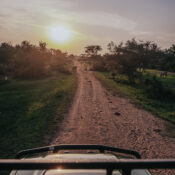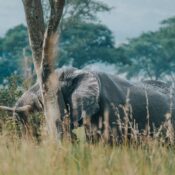Monkeys in Uganda
Monkeys in Uganda
Vervet Monkey (Cercopithecus aethiops)
Vervet monkey, a light-grey guenon, readily identified by its black face and the male’s distinctive blue genitals. Associated with a wide variety of habitats, it is the only guenon (genus Cercopithecus of Old World monkeys) you’re likely to see outside of Uganda’s forests and it is thought to be the most numerous monkey species in the world.
Typically, the vervet monkey has a yellow to greenish-brown coat with white undersides and white fur on their brows and cheeks. They have bluish skin on their abdomens while their faces, hands and feet are all black-skinned.
Males of all species of vervets have bright blue scrotal areas contrasting with red penises. This striking coloration, when combined with the white fur of their undersides is highlighted in what is referred to as the “red, white, and blue display”.
Infant vervets are born with black natal coats and pink faces that gradually change to the adult coloration by 12 weeks of age.
All vervet males and females are sexually dimorphic and wild adult males weigh between 3.9 and 8.0 kg (8.60 and 17.6 lb), averaging 5.5 kg (12.1 lb), and measure between 420 and 600 mm (1.37 and 1.97 ft), averaging 490 mm (1.61 ft) from the top of the head to the base of the tail. Wild adult females weigh between 3.4 and 5.3 kg (7.50 and 11.7 lb) and average 4.1 kg (9.04 lb), and measure between 300 and 495 mm (11.8 in and 1.62 ft), averaging 426 mm (1.40 ft).

Vervet monkeys move quadrupedally (on all fours) and they are equally as comfortable on the ground as they are in the trees. They are semi-terrestrial and semi-arboreal, spending time feeding and traveling on the ground during the day and retreating to the trees to sleep at night. These monkeys have the characteristic cheek-pouches like other members of the super family Cercopithecoidea which allow them to forage and store food to be eaten later.
Lifespan in wild vervet monkey is difficult to characterize because of high rates of predation in the long-term study areas. One female was at least 13 years old when she died and females in captivity have lived this long. Between 11 and 12 years, serious health problems are seen in captive vervets and this is probably the upper limit of their lifespan (Fairbanks & McGuire 1986).
Species Found in Uganda
The vervet monkey is also known as the green, tantalus, savanna and grivet monkey. More than 20 races are recognized, and some authorities group these races into four distinct species.
At least four Vervet monkey races are found in Uganda:
- the black-faced vervet (C. a. centralis),
- Naivasha vervet (C. a. callidus),
- Jebel Mara tantalus (C. a. marrensis) and
- Stuhlmann’s green monkey (C. a. stuhlmanni).
Vervet monkeys are widespread and common in Uganda, even outside of national parks, but they are absent from forest interiors and Afro-alpine habitats.
Golden Monkey Trekking in Uganda
Golden Monkeys are beautiful unique primates found on the slopes of the Virunga volcanoes which are shared between Rwanda, Uganda and DR Congo. In Uganda, golden monkey trekking is done in Mgahinga gorilla national park in south-western Uganda.
Golden monkey trekking is an active tour compared to Chimpanzee trekking and gorilla trekking in certain instances because it is done in the mountainous area and they are continuously moving which requires you to follow them, they are small and fast in their movements. They prefer to rummage through the bamboo sections of the forest because eating the young bamboo shoots.
They live in groups of about 30 individuals or more roaming over a large territory. You will obtain a golden monkey trekking permit in advance from your tour agency, specify the date for which you would like to trek the golden monkeys.
The golden monkey trekking starts early morning with briefing at 7 am at the park headquarters before trekkers can start the trip into the park. You spend an hour with the golden monkeys after spotting them. The trekking generally takes about 2 hours depending on where they nested the previous night and how far it is from the starting point.
What to Carry
- Insect repellent,
- Day pack for your lunch in case the trek takes longer than expected.
- Water for drinking,
- Wear long sleeved shirts, trousers,
- Waterproof hiking boots and a good mood.
- Remember to pick a walking stick at the briefing point or your hotel, you will appreciate the support on the sometimes slippery paths.
Just like gorilla trekking we highly recommend you go along with a porter to provide an extra support with the day pack and the slippery places.
Red-tailed Monkey (Cercopithecus ascinius)
Another widespread forest guenon, the red-tailed monkey is brownish in appearance with white cheek whiskers, a coppery tail and a distinctive white, heart-shaped patch on its nose, giving rise to its more descriptive alternative name of black-cheeked white-nosed monkey.
It is normally seen singly, in pairs or in small family groups, but it also associates with other monkeys and has been known to accumulate in groups of up to 200. The race found in Uganda is Cercopithecus ascanius schmidti.
Red-tailed and blue monkeys regularly interbreed in the Kibale Forest. Red-tailed monkeys occur in Kibale Forest, Bwindi, Semliki and Queen Elizabeth national parks, as well as in Budongo, Mpanga and several other forest reserves.

Population
This species is locally common throughout its range. Densities of C. a. schmidti are 8-184 ind./km² (1.0-13.3 groups/km²; Cords and Sarmiento 2013). In Budongo Forest, Uganda, densities higher in heavily logged forest (46-60 ind./km²) compared to unlogged forest (8-19 ind./km²). These findings contrast with those of Chapman and Lambert (2000) for Kibale NP, Uganda, who report highest group densities (4.8-11.5 groups/km²) in lightly logged forest, intermediate densities in unlogged forest (3.8-5.6 groups/km²) and lowest densities in heavily logged forest (1.0-2.5 groups/km²).

The red-tailed monkey is an arboreal frugivore-insectivore that also feeds on young leaves. The primate species is found in moist lowland, submontane and montane forests, swamp, riverine and gallery forest, and forest mosaic. It occurs in secondary or regenerating forests, forest islands and plantations, and prefers forest edges. It is absent from the interior of primary forest.
Typical group size is 25–35 individuals (Cords and Sarmiento 2013).
Red Colobus Monkey (Piliocolobus tephrosceles)
Listed on the IUCN Red List as endangered, the Red Colobus Monkey is suspected to have undergone a decline exceeding 50% during the past three generations (ca 30 years) caused by human-induced habitat loss and hunting. This relatively large red-grey monkey has few distinguishing features other than its slightly tufted crown. It is highly sociable and normally lives in scattered troops of 50 or more animals.
About 15 races of red colobus are recognized, many of which are considered by some authorities to be distinct species.
In Uganda, red colobus monkeys are largely restricted to Kibale Forest National Park and environs, where they are especially common in the Bigodi Wetland Sanctuary, though they do also occur in small numbers in Semliki National Park.

Habitat and Ecology
This species occurs in a wide variety of forest types, including riverine and gallery forest, forest-miombo savanna mosaic, old-growth lowland, mid-altitude, and montane moist rain forest, degraded secondary forests, and raphia palm swamps.
In Kibale, red colobus monkey is most abundant in moist, old-growth, evergreen forest with emergent trees reaching 50 meters in height and it can persist in lightly logged forest as long as important food trees remain.
They live in groups averaging about 45–50 individuals in Kibale Forest, and 55–59 individuals in Gombe but the mean group size recorded in Mbizi was 41 and in Mbuzi, 34.
for more information visit
All Categories
Recent Posts
Kidepo Valley National Park
The Kabaka’s lake
What is the African elephant?
Tags
Quick booking process
+256 393254072


